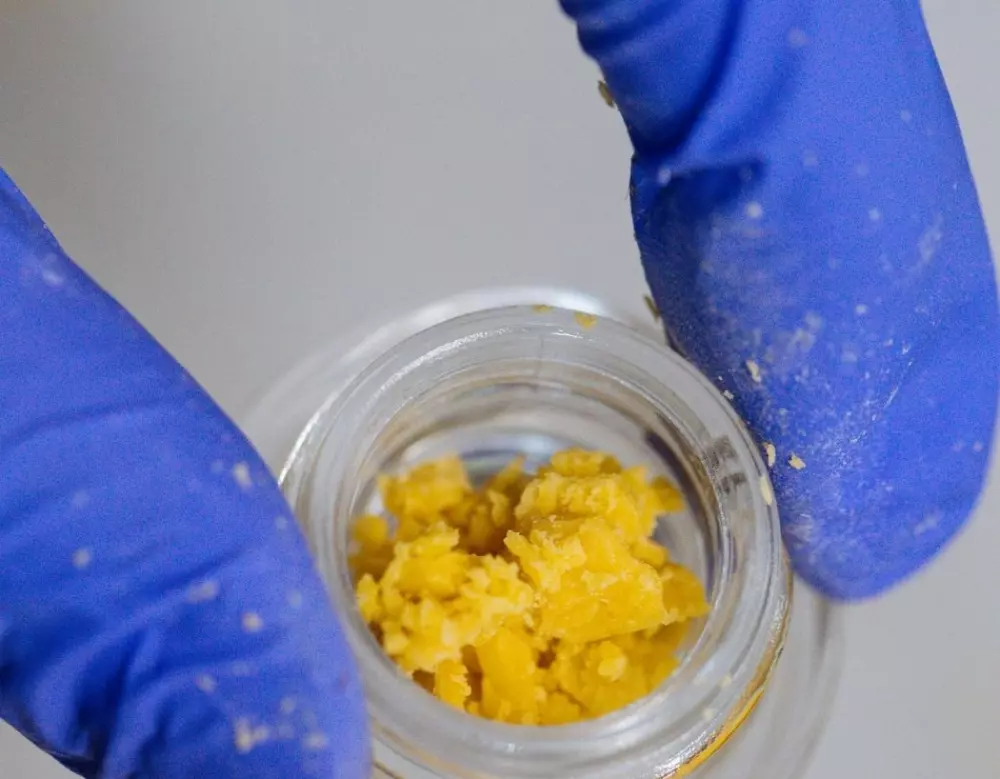Crumble is a cannabis concentrate produced by solvent extraction. It is very similar to shatter but is a bit different when it comes to its physical properties and consistency. As is indicated by its name, it is crumbly and has beeswax or cheese-like consistency, which aside from all the common applications of concentrates, also makes it much more suitable for 'sprinkling' on top of bowls or incorporating into joints.
As is the case with all solvent-extracted concentrates, the potency of crumble is remarkably high - it can contain up to 85-90% THC. Of course, medicinal and non-psychoactive CBD versions with a 0% THC content also exist on the market and they can be vaped or smoked in the exact same way.
What makes crumble different from other concentrates?
When it comes to their chemical constituents,
all concentrates produced by solvent extraction are very similar, or even identical. They only differ in their consistency and appearance. Crumble is the most 'crumbly' of all the concentrates - this quality comes from slight variations in the final purging process, in which any leftover solvent is evaporated to produce the finished concentrate.
Generally, crumble is purged and whipped for longer and as a result, is more 'dry'.
Unfortunately, the more powdery consistency of crumble gives it more air-exposed surface area, which leads to a somewhat shorter shelf-life. It's important to store crumble in well-sealed containers and away from heat and sunlight.
The degradation of crumble over time leads to changes in color - it will lose its beautiful golden glow and become darker. It will also become even more dry and crumbly.
Compared to shatter or other concentrates, crumble is not a lower quality product. It may only seem that way, because shatter looks more 'pretty' and appears purer, due to its crystalline structure. But crumble is becoming more and more popular as people are realizing that the beautiful, glass-like consistency of shatter doesn't necessarily mean it's superior in any way.
What is crumble suitable for?
Of all the different concentrates, crumble is the one that is the most convenient for mixing with whole flower material in order to increase its potency - you can easily sprinkle it on some bud prior to rolling it in a joint, or packing it in a bowl.
But this doesn't mean that crumble was specifically made for mixing with flower - most users still prefer to dab crumble in a dab rig, or vaporize it in an electronic vaporizer. Vaporizing or dabbing is done in order to avoid the unhealthy inhalation of smoke produced by the high-temperature burning of dry flower material.
When crumble is dabbed, a different, spoon-shaped dabber tip is usually used to take the dab and place it into the nail. Because crumble is not as sticky and buttery as other, more fluid concentrates, putting a piece of crumble inside the heated nail is easy and can even be done with your fingers, without a dabber, by simply dropping a pinched dab inside the nail.
Because crumble is convenient both for mixing with flower material and for vaporizing, it is considered the most versatile of all concentrates. Of course, it can also be used for making edibles. Keep in mind that just like other concentrates, most of its THC content is in a THCA form.
THCA requires decarboxylation at a sufficient temperature in order to turn it into the psychoactive THC. This of course happens naturally during vaping or smoking.
How is crumble made?
The process is the same one used to produce all the other solvent-extracted concentrates. Under pressure, chilled butane (or sometimes propane, ethanol, or another solvent) passes through a flower-packed column, after which the concentrate is precipitated by chilling. After that, the separated concentrate undergoes purging, which gets rid of all the final traces of the solvent, leaving only the pure concentrate behind.
Crumble is purged at a relatively high temperature, which leads to quicker evaporation. Unlike the slower process used to produce shatter, the quicker purging process involved in the manufacturing of crumble doesn't allow much time for the molecules to rearrange in a crystalline structure, As a result, a more crumbly structure is achieved. Before purging, crumble is typically whipped.
The whipping process is just simple mechanical agitation, designed to scramble the structure of the material, further contributing to its crumbly texture.
